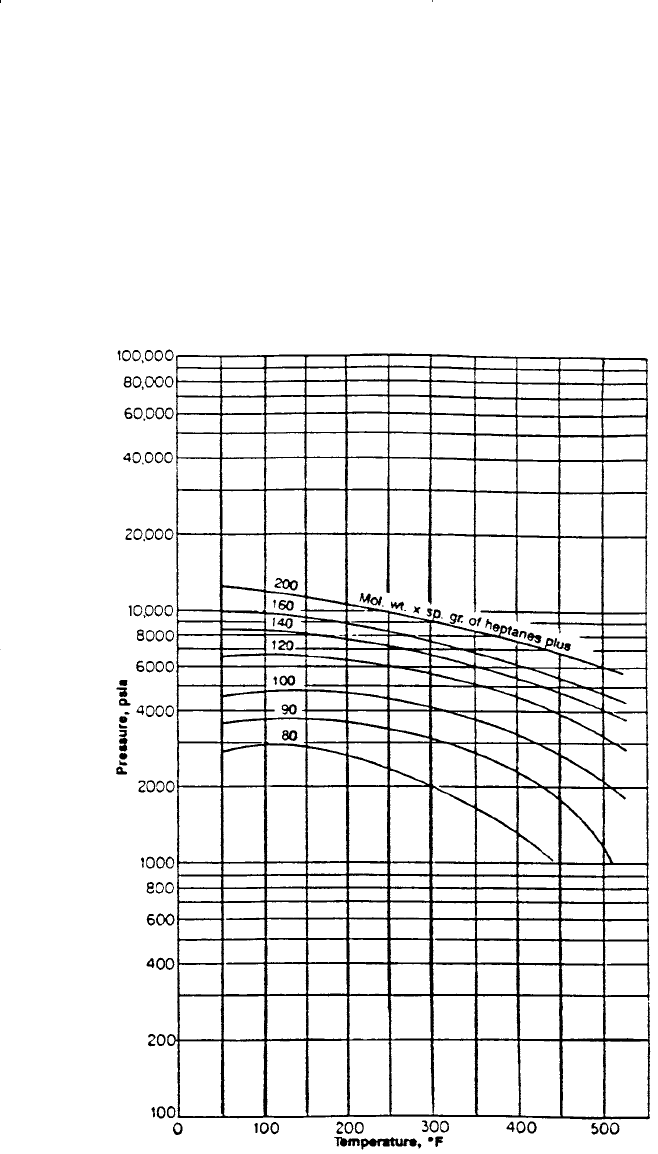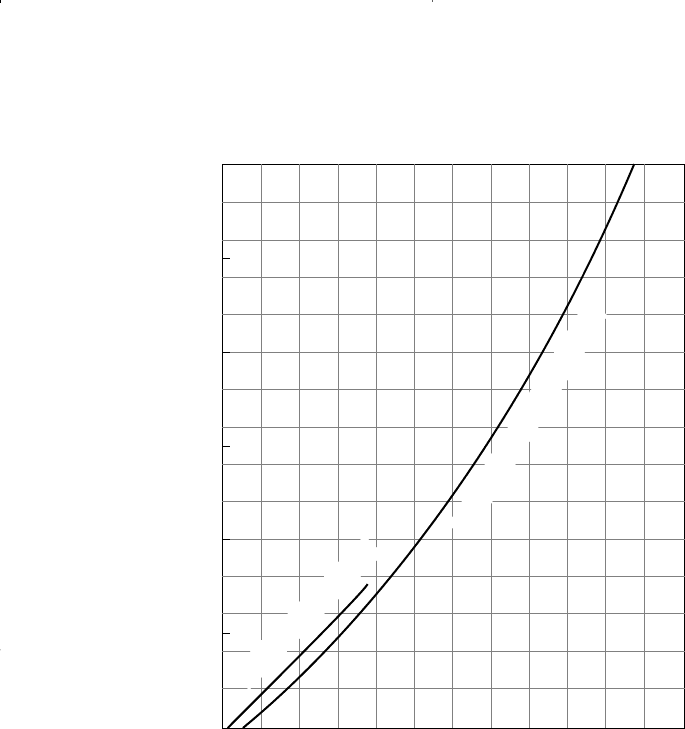Tarek Ahmed. Reservoir engineering handbook
Подождите немного. Документ загружается.


Rzasa’s Method
Rzasa, Glass, and Opfell (1952) presented a simplified graphical correla-
tion for predicting the convergence pressure of light hydrocarbon mixtures.
They used the temperature and the product of the molecular weight and spe-
cific gravity of the heptanes-plus fraction as correlating parameters. The
graphical illustration of the proposed correlation is shown in Figure 15-4.
Figure 15-4. Rzasa’s convergence pressure correlation. (Courtesy of the American
Institute of Chemical Engineers.)
1048 Reservoir Engineering Handbook
Reservoir Eng Hndbk Ch 15 2001-10-25 17:41 Page 1048

The graphical correlation is expressed mathematically by the follow-
ing equation:
where = molecular weight of C
7+
= specific gravity of C
7+
T = temperature, °R
a
1
– a
3
= coefficients of the correlation with the following
values:
a
1
= 6,124.3049
a
2
= –2,753.2538
a
3
= 415.42049
The above mathematical expression can be used for determining the con-
vergence pressure of hydrocarbon mixtures at temperatures in the range
of 50 to 300°F.
Whitson and Torp Correlation
Whitson and Torp (1981) reformulated Wilson’s equation (Equation
15-17) to yield accurate results at higher pressures. Wilson’s equation
was modified by incorporating the convergence pressure into the correla-
tion, to give:
with
where p = system pressure, psig
p
k
= convergence pressure, psig
T = system temperature, °R
i
= acentric factor of component i
A
p
p
k
=−
1
07.
K
p
p
p
p
A
T
T
i
ci
k
A
ci
i
ci
=
+
(
)
−
(
)
−1
537 1 1exp . ω 15 - 28
γ
(
)
+
C
7
M
C
(
)
+7
pMa
M
T
k
C
i
i
C
i
=− +
[]
+
(
)
−
(
)
+
+
=
∑
2 381 8542 46 341487
460
7
7
1
3
,. . γ
γ
15 - 27
Vapor–Liquid Phase Equilibria 1049
Reservoir Eng Hndbk Ch 15 2001-10-25 17:41 Page 1049

Example 15-3
Rework Example 15-2 and calculate the equilibrium ratios using the
Whitson and Torp method.
Solution
Step 1. Determine the convergence pressure from Equation 15-27 to give
P
k
= 9,473.89.
Step 2. Calculate the coefficient A:
Step 3. Calculate the equilibrium ratios from Equation 15-28 to give:
p
c
,
Component psia T
c
, °R
CO
2
1071 547.9 0.225 2.9
N
2
493 227.6 0.040 14.6
C
1
667.8 343.37 0.0104 7.6
C
2
707.8 550.09 0.0968 2.1
C
3
616.3 666.01 0.1524 0.7
i – C
4
529.1 734.98 0.1848 0.42
n – C
4
550.7 765.65 0.2010 0.332
i – C
5
490.4 829.1 0.2223 0.1749
n – C
5
488.6 845.7 0.2539 0.150
C
6
436.9 913.7 0.3007 0.0719
C
7+
320.3 1139.4 0.5069 0.683(10
–3
)
EQUILIBRIUM RATIOS FOR THE PLUS FRACTION
The equilibrium ratios of the plus fraction often behave in a manner
different from the other components of a system. This is because the plus
fraction in itself is a mixture of components. Several techniques have
been proposed for estimating the K value of the plus fractions. Some of
these techniques are presented here.
K
pp
A
T
i
ci ci
i
ci
=+–
9474 1000
537 1 1
610
0 793
1
()
−
.
exp . ω
A =−
=1
1000
9474
0 793
07.
.
1050 Reservoir Engineering Handbook
Reservoir Eng Hndbk Ch 15 2001-10-25 17:41 Page 1050

Campbell’s Method
Campbell (1976) proposed that the plot of the log of K
i
versus for
each component is a linear relationship for any hydrocarbon system. Camp-
bell suggested that by drawing the best straight line through the points for
propane through hexane components, the resulting line can be extrapolated
to obtain the K value of the plus fraction. He pointed out that the plot of log
K
i
versus 1/T
bi
of each heavy fraction in the mixture is also a straight-line
relationship. The line can be extrapolated to obtain the equilibrium ratio of
the plus fraction from the reciprocal of its average boiling point.
Winn’s Method
Winn (1954) proposed the following expression for determining the
equilibrium ratio of heavy fractions with a boiling point above 210°F.
where = value of the plus fraction
= K value of n-heptane at system pressure, temperature,
and convergence pressure
= K value of ethane
b = volatility exponent
Winn correlated, graphically, the volatility component b of the heavy
fraction, with the atmosphere boiling point, as shown in Figure 15-5.
This graphical correlation can be expressed mathematically by the fol-
lowing equation:
where T
b
= boiling point, °R
= coefficients with the following values:
a
1
= 1.6744337
a
2
= –3.4563079 × 10
–3
a
3
= 6.1764103 × 10
–6
a
4
= 2.4406839 × 10
–6
a
5
= 2.9289623 × 10
2
aa
1
5
−
baaT aT aT
aT
bb
=+ −
(
)
+−
(
)
+−
(
)
+−
(
)
(
)
12 3
2
4
3
5
460 460 460
460/15-30
K
C
7
K
C
7
K
C
+
K
K
KK
C
C
CC
b
+
=
(
)
(
)
7
27
15 - 29
T
ci
2
Vapor–Liquid Phase Equilibria 1051
Reservoir Eng Hndbk Ch 15 2001-10-25 17:41 Page 1051

Figure 15-5. Volatility exponent. (Courtesy of the Petroleum Refiner.)
Katz’s Method
Katz et al. (1957) suggested that a factor of 0.15 times the equilibrium
ratio for the heptane component will give a reasonably close approxima-
tion to the equilibrium ratio for heptanes and heavier. This suggestion is
expressed mathematically by the following equation:
APPLICATIONS OF THE EQUILIBRIUM RATIO
IN RESERVOIR ENGINEERING
The vast amount of experimental and theoretical work that has been
performed on equilibrium ratio studies indicates their importance in solv-
ing phase equilibrium problems in reservoir and process engineering.
Some of their practical applications are discussed next.
KK
CC
77
015
+
=
(
)
.15-31
PETROLEUM FRACTIONS (50
⬚ CUT)
PURE HYDROCARBONS
3.0
2.5
2.0
1.5
1.0
0.5
0
200 300 400 500
VOLATILITY EXPONENT, b
ATMOSPHERIC BOILING POINT, ⬚F
600 700 800
1052 Reservoir Engineering Handbook
Reservoir Eng Hndbk Ch 15 2001-10-25 17:41 Page 1052

Dew-Point Pressure
The dew-point pressure p
d
of a hydrocarbon system is defined as the
pressure at which an infinitesimal quantity of liquid is in equilibrium with
a large quantity of gas. For a total of 1 lb-mol of a hydrocarbon mixture,
i.e., n = 1, the following conditions are applied at the dew-point pressure:
n
L
= 0
n
v
= 1
Under these conditions, the composition of the vapor phase y
i
is equal to the
overall composition z
i
. Applying the above constraints to Equation 15-14
yields:
where z
i
= total composition of the system under consideration.
The solution of Equation 15-32 for the dew-point pressure p
d
involves a
trial-and-error process. The process is summarized in the following steps:
Step 1. Assume a trial value of p
d
. A good starting value can be obtained
by applying Wilson’s equation (Equation 15-17) for calculating
K
i
to Equation 15-32 to give:
Solving for p
d
yields:
Another simplified approach for estimating the dew-point pres-
sure is to treat the hydrocarbon mixture as an ideal system with
the equilibrium ratio K
i
as given by Equation (15-4):
initial p
z
p
T
T
d
i
ci i
ci
i
exp .
=
+
(
)
−
(
)
∑
1
5371 1ω
15 - 33
z
p
p
T
T
i
ci
d
i
ci
i
exp .5371 1
1
+
(
)
−
=
∑
ω
z
K
i
i
i
∑
(
)
15 - 32
Vapor–Liquid Phase Equilibria 1053
Reservoir Eng Hndbk Ch 15 2001-10-25 17:41 Page 1053

Substituting the above expression into Equation (15-29) gives:
Solving for p
d
yields:
Step 2. Using the assumed dew-point pressure, calculate the equilibrium
ratio, K
i
, for each component at the system temperature.
Step 3. Compute the summation of Equation 15-33.
Step 4. If the sum is less than 1, steps 2 and 3 are repeated at a higher initial
value of pressure; conversely, if the sum is greater than 1, repeat the
calculations with a lower initial value of p
d
. The correct value of the
dew-point pressure is obtained when the sum is equal to 1.
Example 15-4
A natural gas reservoir at 250°F has the following composition:
Component z
i
C
1
0.80
C
2
0.05
C
3
0.04
i – C
4
0.03
n – C
4
0.02
i – C
5
0.03
n – C
5
0.02
C
6
0.005
C
7+
0.005
If the molecular weight and specific gravity of C
7+
are 140 and 0.8, cal-
culate the dew-point pressure.
initial p
z
p
d
i
vi
i
=
=
∑
1
1
z
p
p
i
d
vi
i
=
∑
10.
K
p
p
i
vi
=
1054 Reservoir Engineering Handbook
Reservoir Eng Hndbk Ch 15 2001-10-25 17:41 Page 1054

Solution
Step 1. Calculate the convergence pressure of the mixture from Rzasa’s
correlation, i.e., Equation 15-27, to give:
p
k
= 5000 psia
Step 2. Determine an initial value for the dew-point pressure from Equa-
tion 15-33 to give:
p
d
= 207 psia
Step 3. Using the K-value curves in Appendix A, solve for the dew-point
pressure by applying the iterative procedure outlined previously,
and by using Equation 15-32, to give:
K
i
at K
i
at
207 K
i
at 222.3
Component z
i
psia z
i
/K
i
300 psia z
i
/K
i
psia z
i
/K
i
C
1
0.78 19 0.0411 13 0.06 18 0.0433
C
2
0.05 6 0.0083 4.4 0.0114 5.79 0.0086
C
3
0.04 3 0.0133 2.2 0.0182 2.85 0.0140
i – C
4
0.03 1.8 0.0167 1.35 0.0222 1.75 0.0171
n – C
4
0.02 1.45 0.0138 1.14 0.0175 1.4 0.0143
i – C
5
0.03 0.8 0.0375 0.64 0.0469 0.79 0.0380
n – C
5
0.02 0.72 0.0278 .55 0.0364 0.69 0.029
C
6
0.005 0.35 0.0143 0.275 0.0182 0.335 0.0149
C
7+
0.02 0.255* 0.7843 0.02025* 0.9877 0.0243* 0.8230
0.9571 1.2185 1.0022
*Equation 15-29
The dew-point pressure is therefore 222 psia at 250°F.
Bubble-Point Pressure
At the bubble point p
b
the hydrocarbon system is essentially liquid,
except for an infinitesimal amount of vapor. For a total of 1 lb-mol of the
hydrocarbon mixture, the following conditions are applied at the bubble-
point pressure:
n
L
= 1
n
v
= 0
Vapor–Liquid Phase Equilibria 1055
Reservoir Eng Hndbk Ch 15 2001-10-25 17:41 Page 1055

Obviously, under the above conditions, x
i
= z
i
. Applying the above con-
straints to Equation 15-15 yields:
Following the procedure outlined in the dew-point pressure determina-
tion, Equation 15-34 is solved for the bubble-point pressure p
b
by assum-
ing various pressures and determining the pressure that will produce K
values that satisfy Equation 15-34.
During the iterative process, if:
Wilson’s equation can be used to give a good starting value for the itera-
tive process:
Solving for the bubble-point pressure gives:
Assuming an ideal solution behavior, an initial guess for the bubble-point
pressure can also be calculated by replacing the K
i
in Equation 15-34
with that of Equation 15-4 to give:
or
pzp
bivi
i
=
(
)
(
)
∑
15 - 36
z
p
p
i
vi
b
i
=
∑
1
pzp
T
T
bici
ci
i
=+
(
)
−
(
)
∑
exp .5371 1ω
15 - 35
z
p
p
T
T
i
ci
b
ci
i
exp .5371 1 1+
(
)
−
=
∑
ω
zK
ii
(
)
>→
∑
1 the assumed pressure is low
i
zK
ii
(
)
<→
∑
1 the assumed pressure is high
i
zK
ii
i
(
)
=
(
)
∑
1
15 - 34
1056 Reservoir Engineering Handbook
Reservoir Eng Hndbk Ch 15 2001-10-25 17:41 Page 1056

Example 15-5
A crude oil reservoir has a temperature of 200
o
F and a composition as
given below. Calculate the bubble-point pressure of the oil.
Component x
i
C
1
0.42
C
2
0.05
C
3
0.05
i – C
4
0.03
n – C
4
0.02
i – C
5
0.01
n – C
5
0.01
C
6
0.01
C
7+
0.40*
*(M) = 216.0
() = 0.8605
(T
b
) = 977°R
Solution
Step 1. Calculate the convergence pressure of the system by using Standing’s
correlation (Equation 15-26):
Step 2. Calculate the critical pressure and temperature by the Riazi and
Daubert equation (Equation 1-2), to give:
Step 3. Calculate the acentric factor by employing the Edmister correla-
tion (Equation 1-3) to yield:
Step 4. Estimate the bubble-point pressure from Equation 15-35 to give:
p
b
= 3,924 psia
ω=0 653.
p psia
TR
c
c
=
=°
230 4
1 279 8
.
,.
p psia
k
=
(
)
(
)
−=60 216 4200 8760
C
7+
C
7+
C
7+
Vapor–Liquid Phase Equilibria 1057
Reservoir Eng Hndbk Ch 15 2001-10-25 17:41 Page 1057
